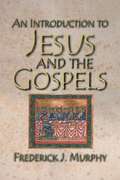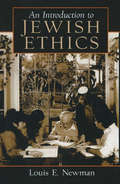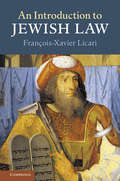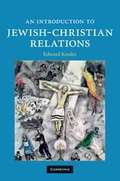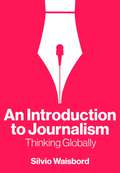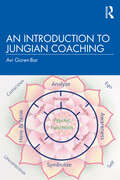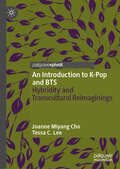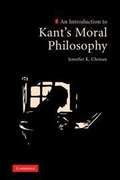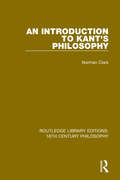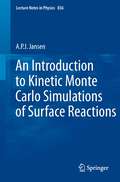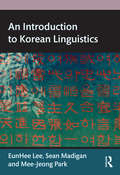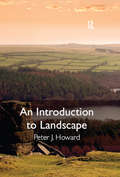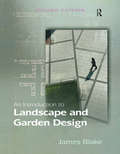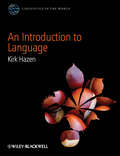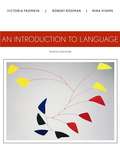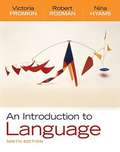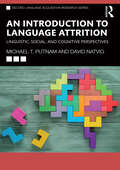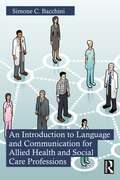- Table View
- List View
An Introduction to Jean-Yves Lacoste (Routledge Studies in Theology, Imagination and the Arts)
by Joeri SchrijversIntroducing the thought of philosopher and theologian Jean-Yves Lacoste, this book provides an overview spanning Lacoste's earliest works on sacramentality to his latest work Etre en Danger (2011) in which Lacoste opens up the liturgical experience onto a spiritual experience of life. Schrijvers unfolds the logic of what Lacoste calls 'the liturgical experience' from its violent variety in Expérience et Absolu to the logic of love and love's possibility as it is developed in the later works. Throughout the book, the focus is on Lacoste's dialogue with Heidegger and through this his attempt to widen the scope of phenomenology to include the phenomenality of the divine.
An Introduction to Jesus and the Gospels 18183
by Frederick J. Murphy“Jesus and the Gospels” is one of the most popular religion courses at colleges, and it is required at many seminaries and divinity schools. This textbook, written by an award-winning educator, is designed for a semester-long course in both these settings. Moreover, it could be used as a supplementary text in courses on christology, the historical Jesus, New Testament literature, and the Bible.Murphy will provide an introduction to the gospels that does justice to the full range of modern critical methods and insights. He will discuss the implications of these methods for how we understand the nature of the gospels and how we can read them today. The chapters will sketch the portrait of Jesus that emerges from each gospel, and then examine the “canonical” view of Jesus by comparing and contrasting these pictures, as well as the ones that emerge from the non-canonical gospels and from the modern quest for the historical Jesus. Chapter list: Introduction, Theological and Historical Backgrounds; Chapter 1, What is a Gospel? Chapter 2, History of Critical Methods for Gospel Study; Chapter 3, The Gospel of Mark; Chapter 4, Q; Chapter 5, Matthew; Chapter 6, Luke; Chapter 7, John; Chapter 8, Other Gospels (Gospel of Thomas, Infancy Gospels, other Apocryphal Gospels); Chapter 8, Christian Interpretations of Jesus; Chapter 9, The Historical Jesus; Chapter 10, Conclusion; Glossary; Further Reading; Notes; Subject Index. (Charts, sidebars, illustrations, and maps.)
An Introduction to Jewish Ethics
by Louis NewmanFor courses in Religion, Judaism and Ethics. This text offers an overview of the Jewish ethical tradition as it has evolved from biblical times to the present. Provides an overview of the central beliefs of classical Judaism and the ways in which these frame traditional Jewish approaches to issues in ethics, both theoretical and practical.
An Introduction to Jewish Law
by François-Xavier LicariJewish law is a singular legal system that has been evolving for generations. Often conflated with Biblical law or Israeli law, Jewish law needs to be studied in its own right. An Introduction to Jewish Law expounds the general structure of Jewish law and presents the cardinal principles of this religious legal system. An introduction to modern Jewish law as it applies to the daily life of Jews around the world, this volume presents Jewish law in a way that answers all the questions that a student of comparative law would ask when encountering an unfamiliar legal system. Sources of Jewish law such as revelation, rabbinical and communal legislation, judicial decisions, and legal reasoning are defined and analyzed, and the authority of who decides what Jewish law is and why their decisions are binding is investigated.
An Introduction to Jewish-Christian Relations
by Edward KesslerRelations between Christians and Jews over the past two thousand years have been characterised to a great extent by mutual distrust and by Christian discrimination and violence against Jews. In recent decades, however, a new spirit of dialogue has been emerging, beginning with an awakening among Christians of the Jewish origins of Christianity, and encouraging scholars of both traditions to work together. An Introduction to Jewish-Christian Relations sheds fresh light on this ongoing interfaith encounter, exploring key writings and themes in Jewish-Christian history, from the Jewish context of the New Testament to major events of modern times, including the rise of ecumenism, the horrors of the Holocaust, and the creation of the state of Israel. This accessible theological and historical study also touches on numerous related areas such as Jewish and interfaith studies, philosophy, sociology, cultural studies, international relations and the political sciences.
An Introduction to Journalism: Thinking Globally
by Silvio WaisbordJournalism remains a vital, irreplaceable institution in the public sphere, even though technology, political and economic trends, and globalization continue to impact it in negative ways.An Introduction to Journalism is the new go-to textbook for journalism studies. Organized around three thematic sections – structures, practices, and change and continuity – this textbook covers a broad range of issues central to the study of journalism. These include the nature of news as a socio-cultural construct; the impact of social forces (political, economic, technology, cultural) on journalistic practices and news content; the origin and the impact of journalistic norms, values, and ideologies; patterns of news access and consumption; the relation between journalism and public life; and the role of the press in democracy and authoritarianism. Taking a global perspective throughout, the textbook is grounded in the conviction that we need to examine developments across countries and regions, and understand how global forces shape news, journalism, and the news industry. Supported by extensive examples and clear case studies throughout, this accessible textbook, written by a leading scholar in the field, provides a comprehensive and analytical survey of the key themes that shape journalism. It is essential reading for undergraduate students of journalism studies.
An Introduction to Judaism
by Nicholas De LangeIn this new edition contemporary Judaism is presented in all its rich diversity, including both traditional and modern theologies as well as secular forms of Jewish identity. While the focus of the book is on developments that have taken place in the past two hundred years, they are set against a historical background, going back to the Bible. Beginning with a description of the Jewish people as it exists in today's world, it studies the unique concept of Jewish peoplehood and its survival over the centuries in the face of many challenges. An account of the key texts is followed by studies of the different interpretations of the religion, and the ways that life is lived out both in the home and in the community. Jewish theology is described both historically and in terms of contemporary issues. An important and distinctive section considers the goals of Jewish life and faith.
An Introduction to Jungian Coaching
by Avi Goren-BarBased on the psychology of Carl Jung, this illuminating new book invites coaches to extend their toolbox with deep, creative, and efficient professional methods that derive from a new perspective on coaching. In using the unconscious archetypes as a practical active psychological database for change, the Jungian coach can contribute significant modification in the coachee’s expected behavior. Jungian Coaching can be applied in evaluating the coachee, the team, and the corporation. This book translates Jungian psychology into simple comprehensive concepts. Each chapter translates theoretical concepts and rationale to thepractice of coaching. Illustrated with practical examples from the corporate world and life coaching, it offers Jungian Coaching tools and techniques. By integrating the Gestalt psychology principle of the "here and now" into Jungian concepts, the author develops a new coaching tool that enables an activation of archetypes as a useful and empowering coaching experience. A valuable introductory resource for all those involved in coaching relationships, this book can empower coachees and serve as a compass for personal growth. It will be of great interest to practicing coaches, executives, human resource managers, consultants, and psychotherapists.
An Introduction to K-Pop and BTS: Hybridity and Transcultural Reimaginings
by Joanne Miyang Cho Tessa C. LeeThis Palgrave Pivot examines a key area of the Korean Wave or Hallyu, which stands for the global popularity of South Korean popular culture that started in the 1990s. While K-dramas (Korean dramas) have found many viewers throughout Asian countries and some Western countries in recent years, K-pop (Korean popular music) has had broader appeal not only to Asian audiences, but also American (North and South), European, and Middle-Eastern audiences. This book&’s unique contribution is to provide a concise and succinct analysis of K-pop from transcultural perspectives through its most famous example, BTS. The first chapter contextualizes K-pop within the Korean Wave movement. The second and third chapters provide a history of K-Pop, spanning from Seo Taiji and Boys in the early 1990s to the present (including BTS and Blackpink), and presents K-pop as a glocalized phenomenon. The fourth, fifth, and sixth chapters critically examine the most prominent band in the K-pop world, BTS, and the unique connections to their transnational fandom called ARMY.
An Introduction to KMS Weights (Lecture Notes in Mathematics #2362)
by Klaus Erik ThomsenThis book provides an introduction to the theory of KMS weights and KMS states, which play an important role in mathematical physics and other applications of operator algebras. Leading from the definitions to some of the most recent research results, it covers advanced topics such as the Laca-Neshveyev theorem, elements of the modular theory of von Neumann algebras, the geometry of the set of KMS weights, duality (for KMS weights on crossed products), the relationship between KMS weights and traces and the types of factors associated with extremal KMS weights. Some of the material is new, in the sense that the proofs and results are published here for the first time. This relatively self-contained book will be useful both to researchers in the area of operator algebras and to more advanced students who wish to enter this field.
An Introduction to Kant'S Moral Philosophy
by Jennifer K. UlemanImmanuel Kant's moral philosophy is one of the most distinctive achievements of the European Enlightenment. At its heart lies what Kant called the 'strange thing': the free, rational, human will. This introduction explores the basis of Kant's anti-naturalist, secular, humanist vision of the human good. Moving from a sketch of the Kantian will, with all its component parts and attributes, to Kant's canonical arguments for his categorical imperative, this introduction shows why Kant thought his moral law the best summary expression of both his own philosophical work on morality and his readers' deepest shared convictions about the good. Kant's central tenets, key arguments, and core values are presented in an accessible and engaging way, making this book ideal for anyone eager to explore the fundamentals of Kant's moral philosophy.
An Introduction to Kant's Philosophy (Routledge Library Editions: 18th Century Philosophy #8)
by Norman ClarkEmmanuel Kant has the distinction of having introduced a great revolution into philosophy and yet stood the test of time. He stands as one of the great foundation stones of modern thought. This book, first published in 1925, covers Kant’s works essential to his philosophy as a system, and also illustrates his position in the history of thought. It is a clear and accurate statement of Kant’s chief doctrines.
An Introduction to Kinetic Monte Carlo Simulations of Surface Reactions (Lecture Notes in Physics #856)
by A.P.J. JansenKinetic Monte Carlo (kMC) simulations still represent a quite new area of research, with a rapidly growing number of publications. Broadly speaking, kMC can be applied to any system describable as a set of minima of a potential-energy surface, the evolution of which will then be regarded as hops from one minimum to a neighboring one. The hops in kMC are modeled as stochastic processes and the algorithms use random numbers to determine at which times the hops occur and to which neighboring minimum they go. Sometimes this approach is also called dynamic MC or Stochastic Simulation Algorithm, in particular when it is applied to solving macroscopic rate equations. This book has two objectives. First, it is a primer on the kMC method (predominantly using the lattice-gas model) and thus much of the book will also be useful for applications other than to surface reactions. Second, it is intended to teach the reader what can be learned from kMC simulations of surface reaction kinetics. With these goals in mind, the present text is conceived as a self-contained introduction for students and non-specialist researchers alike who are interested in entering the field and learning about the topic from scratch.
An Introduction to Kolmogorov Complexity and Its Applications (Texts in Computer Science)
by Ming Li Paul M. B. Vitányi"The book is outstanding and admirable in many respects. ... is necessary reading for all kinds of readers from undergraduate students to top authorities in the field." Journal of Symbolic Logic Written by two experts in the field, this is the only comprehensive and unified treatment of the central ideas and applications of Kolmogorov complexity. The book presents a thorough treatment of the subject with a wide range of illustrative applications. Such applications include the randomness of finite objects or infinite sequences, Martin-Loef tests for randomness, information theory, computational learning theory, the complexity of algorithms, and the thermodynamics of computing. It will be ideal for advanced undergraduate students, graduate students, and researchers in computer science, mathematics, cognitive sciences, philosophy, artificial intelligence, statistics, and physics. The book is self-contained in that it contains the basic requirements from mathematics and computer science. Included are also numerous problem sets, comments, source references, and hints to solutions of problems. New topics in this edition include Omega numbers, Kolmogorov-Loveland randomness, universal learning, communication complexity, Kolmogorov's random graphs, time-limited universal distribution, Shannon information and others.
An Introduction to Korean Linguistics
by Eunhee Lee Sean Madigan Mee-Jeong ParkAn Introduction to Korean Linguistics is a valuable and comprehensive text for those with an interest in Korean linguistics. This book provides an in-depth introduction to the basics of Korean linguistics, and modern linguistic theory, in an accessible style. It features a step-by-step approach designed to lead the reader through the linguistic make-up of the language, from the basics of its sound system and sentence structure to the semantics of modern spoken Korean. Features include: Detailed chapters covering the core areas in the field of linguistics, including phonetics, phonology, morphology and syntax Clear and accessible explanations which effectively demonstrate the intricacies and subtleties of the Korean language Suggested readings for those interested in expanding their knowledge of a specific topic Exercises designed to complement the factual and analytical issues covered in each chapter A comprehensive glossary of central terms and a companion website offering a wealth of additional materials. Korean is an invaluable language for the study of theoretical and comparative linguistics as it provides important examples and counter-examples to key issues, making An Introduction to Korean Linguistics an essential text for students and professional linguists alike.
An Introduction to LTE: LTE, LTE-Advanced, SAE and 4G Mobile Communications
by Christopher CoxAn Introduction to LTE explains the technology used by 3GPP Long Term Evolution. The book covers the whole of LTE, both the techniques used for radio communication between the base station and the mobile phone, and the techniques used for signalling communication and data transport in the evolved packet core. It avoids unnecessary detail, focussing instead on conveying a sound understanding of the entire system. The book is aimed at mobile telecommunication professionals, who want to understand what LTE is and how it works. It is invaluable for engineers who are working on LTE, notably those who are transferring from other technologies such as UMTS and cdma2000, those who are experts in one part of LTE but who want to understand the system as a whole, and those who are new to mobile telecommunications altogether. It is also relevant to those working in non technical roles, such as project managers, marketing executives and intellectual property consultants. On completing the book, the reader will have a clear understanding of LTE, and will be able to tackle the more specialised books and the 3GPP specifications with confidence. Key features - Covers the latest developments in release 10 of the 3GPP specifications, including the new capabilities of LTE-Advanced Includes references to individual sections of the 3GPP specifications, to help readers understand the principles of each topic before going to the specifications for more detailed information Requires no previous knowledge of mobile telecommunications, or of the mathematical techniques that LTE uses for radio transmission and reception
An Introduction to LTE: LTE, LTE-Advanced, SAE, VoLTE and 4G Mobile Communications
by Christopher CoxFollowing on from the successful first edition (March 2012), this book gives a clear explanation of what LTE does and how it works. The content is expressed at a systems level, offering readers the opportunity to grasp the key factors that make LTE the hot topic amongst vendors and operators across the globe. The book assumes no more than a basic knowledge of mobile telecommunication systems, and the reader is not expected to have any previous knowledge of the complex mathematical operations that underpin LTE. This second edition introduces new material for the current state of the industry, such as the new features of LTE in Releases 11 and 12, notably coordinated multipoint transmission and proximity services; the main short- and long-term solutions for LTE voice calls, namely circuit switched fallback and the IP multimedia subsystem; and the evolution and current state of the LTE market. It also extends some of the material from the first edition, such as inter-operation with other technologies such as GSM, UMTS, wireless local area networks and cdma2000; additional features of LTE Advanced, notably heterogeneous networks and traffic offloading; data transport in the evolved packet core; coverage and capacity estimation for LTE; and a more rigorous treatment of modulation, demodulation and OFDMA. The author breaks down the system into logical blocks, by initially introducing the architecture of LTE, explaining thetechniques used for radio transmission and reception and the overall operation of the system, and concluding with more specialized topics such as LTE voice calls and the later releases of the specifications. This methodical approach enables readers to move on to tackle the specifications and the more advanced texts with confidence.
An Introduction to Landscape
by Peter J. HowardInspiring deep emotion, landscape carries many meanings. This book follows the development of several threads of the concept of landscape as they have evolved across disciplines and across countries, leading to the European Landscape Convention and the designation of cultural landscapes as World Heritage Sites. The book introduces the key notions of landscape, such as landscape as meaning, as picture, as scale, as scenery and as place. It also considers the various factors which influence the way in which landscape is perceived now and in the past, with all of the senses. Finally, it looks of the various ways of protecting, managing and enhancing the landscape, taking into account a future of climate change. Beautifully illustrated and including 'capsules' in each section which provide fascinating insights into subjects from reading pictures, to mapping and GIS, through a discussion of the range of types of landscape to issues such as eco-museums, this book provides an excellent introductory overview for any students with an interest in the landscape around us.
An Introduction to Landscape and Garden Design
by James BlakeHow do you design a landscape book suitable for its intended uses? How can the natural qualities of a landscape be enhanced with new features and focal points? How can you make pedestrians stay on the footpath? What kind of plant, path or wall should you put where, and what sort of contract should you choose for your client's contractor? This refreshingly down-to-earth introduction to the vast subject of landscape design and construction answers all these questions, guiding new students through the many facets of professional practice and welding together the artistic, legal, financial, environmental and management issues which can seem so dauntingly disconnected. Illustrated with original drawings, photographs, sample plans and facsimiles, including a new colour plate section, this readable classic has been fully revised and updated throughout. It opens with a completely new chapter which explains design and aesthetic principles, explores the history of our relationship to landscape, and shows how design principles can be applied to influence reactions to the finished site. The author then considers different elements of hard landscape and their relative merits in different situations. The soft landscape section includes coverage of the effects of mass and form, natural and abstract planting, and the difficult subject of plant selection. A step-by-step guide through all the stages of managing a project, from initial discussions with clients, site inspection, surveying and quoting, through tendering, contracting, contractual agreements, development from concept design to final plans and drawings, as well as maintenance, now includes the current information on CDM regulations and provides readers with a plain-speaking reference on client management and contractual administration. Added to the guide to drawing and lettering is an extensive section on computer-aided design. A bibliography and list of useful organization are also included.
An Introduction to Language
by Kirk HazenAn Introduction to Language offers an engaging guide to the nature of language, focusing on how language works - its sounds, words, structures, and phrases - all investigated through wide-ranging examples from Old English to contemporary pop culture.Explores the idea of a scientific approach to language, inviting students to consider what qualities of language comprise everyday skills for us, be they sounds, words, phrases, or conversationHelps shape our understanding of what language is, how it works, and why it is both elegantly complex and essential to who we areIncludes exercises within each chapter to help readers explore key concepts and directly observe the patterns that are part of all human languageExamines linguistic variation and change to illustrate social nuances and language-in-use, drawing primarily on examples from EnglishAvoids linguistic jargon, focusing instead on a broader and more general approach to the study of language, and making it ideal for those coming to the subject for the first timeSupported by additional web resources - available upon publication at www.wiley.com/go/hazen - including student study aids and testbank and notes for instructors
An Introduction to Language
by Victoria Fromkin Robert Rodman Nina HyamsAssuming no prior knowledge of linguistics, AN INTRODUCTION TO LANGUAGE, Tenth Edition, is appropriate for a variety of fields--including education, languages, psychology, cognitive science, anthropology, English, and teaching English as a Second Language (TESL)--at both the undergraduate and graduate levels. This completely updated edition retains the clear descriptions, humor, and seamless pedagogy that have made the book a perennial best-seller, while adding new information and exercises that render each topic fresh, engaging, and current.
An Introduction to Language (9th Edition)
by Victoria Fromkin Robert Rodman Nina HyamsAssuming no prior knowledge of linguistics, AN INTRODUCTION TO LANGUAGE, Ninth Edition, is appropriate for a variety of fields--including education, languages, psychology, anthropology, English, and teaching English as a Second Language (TESL)--at both the undergraduate and graduate levels. This completely updated edition retains the clear descriptions, humor, and seamless pedagogy that have made the text a perennial best-seller, while adding new information and exercises that render each topic fresh, engaging, and current.
An Introduction to Language Attrition: Linguistic, Social, and Cognitive Perspectives (Second Language Acquisition Research Series)
by Michael T. Putnam David NatvigThis introductory text brings together diverse perspectives and research streams on language attrition – forgetting or loss of language proficiency that can take place in one’s first or additional language, for different reasons, and at different life stages.Offering a comprehensive state-of-the-art overview, Michael T. Putnam and David Natvig define key concepts and the contemporary debates in the field, discussing a variety of structural/grammatical, societal, and psychological/cognitive aspects of this phenomenon and their implications for linguistic theory and language learning.Setting the future research agenda on this subject and with helpful features like discussion questions, this will be an invaluable resource for advanced students and researchers of theoretical & applied linguistics, bilingualism & heritage linguistics, psycholinguistics, sociolinguistics, education, and beyond.
An Introduction to Language and Communication for Allied Health and Social Care Professions
by Simone C. BacchiniBringing insights from linguistics to those without a background in this field, An Introduction to Language and Communication for Allied Health and Social Care Professions enables readers to better appreciate the ways in which language functions simultaneously as an instrument to encode and communicate meaning, build and sustain interpersonal relationships, and express identity. Grounded in the understanding of language as a multifunctional, interactional tool offered by sociolinguistics, pragmatics, and discourse analysis, the book: Provides readers with well-grounded tools that they can use to inform their daily work as well as to reflect upon their own communicative practices and – where necessary – to improve them Features ‘discussion points’ in the form of questions, suggestions for reflection, and small analysis tasks throughout Contains end-of-chapter summaries and suggestions for further reading An Introduction to Language and Communication for Allied Health and Social Care Professions is ideal as a core or supplementary textbook for students on degrees in public health, social work, social care, nursing, and other allied health professions who are taking courses in communication. It is also an invaluable guide for qualified health and social care practitioners, to support both their professional practice and their continuing professional development.
An Introduction to Language and Linguistics
by Deborah Tannen Alison Mackey Deborah Schiffrin Natalie Schilling Ralph Fasold Jeff Connor-Linton Ralph Fasold Elizabeth Zsiga Donna Lardiere Ruth Kramer David Lightfoot Paul Portner Deborah Schiffrin Deborah Tannen Alison Mackey Natalie Schilling Michael T. Ullman Shaligram Shukla Kendall A. King Jeff Connor-Linton Inderjeet Mani Elizabeth Zsiga Donna Lardiere Ruth Kramer David Lightfoot Paul Portner Michael T. Ullman Shaligram Shukla Kendall A. King Inderjeet ManiThis accessible textbook is the only introduction to linguistics in which each chapter is written by an expert who teaches courses on that topic, ensuring balanced and uniformly excellent coverage of the full range of modern linguistics. Assuming no prior knowledge the text offers a clear introduction to the traditional topics of structural linguistics (theories of sound, form, meaning, and language change), and in addition provides full coverage of contextual linguistics, including separate chapters on discourse, dialect variation, language and culture, and the politics of language. There are also up-to-date separate chapters on language and the brain, computational linguistics, writing, child language acquisition, and second-language learning. The breadth of the textbook makes it ideal for introductory courses on language and linguistics offered by departments of English, sociology, anthropology, and communications, as well as by linguistics departments.

